The ‘Cornhusker’ state of Nebraska has a number of feathered celebrities who aren’t there simply for the delicious corn. Nebraska is home to rivers, bluffs, sandhills, and mesas and because of these diverse environs there is a little something for many a different species of bird to enjoy. Today we’ll talk about some of the birds you can see in Nebraska and we’ll also go into detail about the places where they like to spend their time, as well as what they like to eat, and finally we’ll close out with some feeder tips and share a few birding hotspots you can visit as well. Let’s talk about the popular backyard birds of Nebraska!
3 Categories –465 Birds
With all those lovely geographical factors Nebraska is quite the Mecca for many a species of bird. Over 465, in fact, if we want to get technical. While we have nowhere near the space needed to cover that many we can certainly provide you with a good starting point of birds divided into seasonal spotting-times thusly:
- Year-round Resident birds
- Birds of Spring, Summer, and Early Fall
- Fall and Winter Birds
Once you know WHEN to look you’ll also have some handy information about where to lok as well and we’ll even give you some information about their favorite foods. Let’s start with the birds that make Nebraska their year-round home.
Nebraska ’s Year-round Resident birds
These are the true-blue Nebraskan local birds and you can see them at any time of the year. Like yourself, they’ve fallen in love with this beautiful state and they don’t let anything like seasonal variance get in their way. See if you can spot one of the following year-round resident birds we’ve listed below:
- Mourning Dove
- Northern Flicker
- European Starling
- Dark-eyed Junco
- Barn Swallow
Mourning Dove – Zenaida macroura
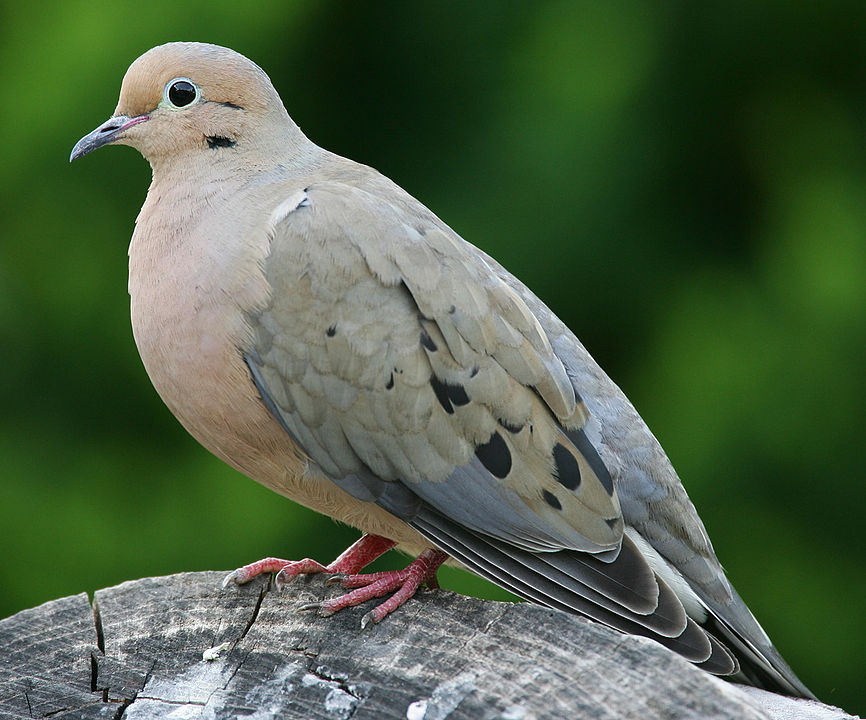
Coloration and Markings: Mourning Doves are colored brown or gray, with long, gray or brown wings which bear a heavy concentration of creamy tan color along with distinctive black spots. Their tails are long and pointy and the breast and underbelly of this bird are white mixed with tan., with the color getting a little gray at the rump. The most striking tan will be in the face and it brings out the thin, white eyeline on this Dove. This bird has a medium-length, straight black bill.
Size: These birds measure in at 9.1 – 13.4 inches in length with wingspans of approximately 17.7 inches.
Habitat: These Doves are city birds and you’ll spot them on phone lines, fences, or sometimes just waddling down the street. They will happily visit a backyard feeder provided that it is stocked and there are no predator birds nearby to scare them off.
Diet: Cracked corn, millet, wheat, and oats are an easy way to get and keep the attentions of the Mourning Dove.
Northern Flicker – Colaptes auratus
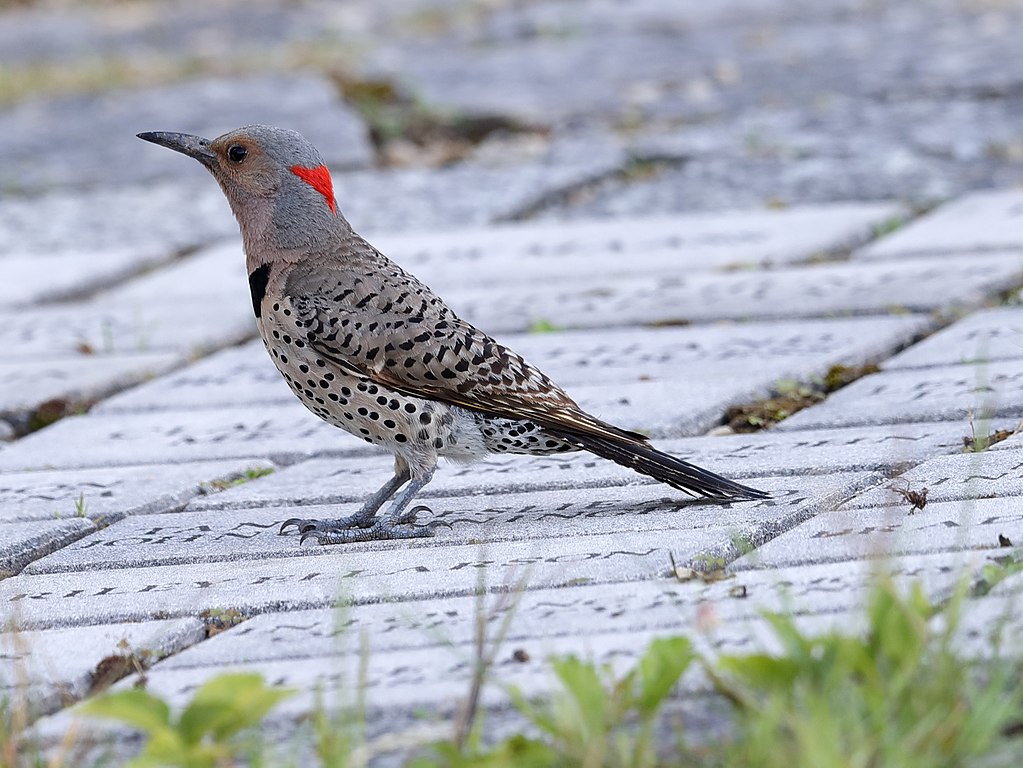
Coloration and Markings: These are crazy looking birds and you will love their plumage! Northern Flickers tend to have an overall gray or brown color and you will see it on their back, with long, brownish wings covered in distinctive black spots and long, pointy black tails which are a vibrant red or yellow on the underside. The breast and underbelly of this bird are a sort of olive brown or gray with black spots and they have white rumps, though this is hard to spot when the bird is at rest. At the top of the breast you will notice another distinct marking in the form of a black crescent, around which the coloration lightens to almost white, and above this crescent the bird has a long, gray neck. The gray goes up to about mid-eye level, with brown above, and a red stripe is often present going from the bill to the cheek. These birds have long, gray, slightly-curved bills.
Size: These are good sized birds, measuring in at 11 – 12 inches from tip to tail with wingspans of approximately 16.5 to 20.1 inches.
Habitat: These birds love open areas, such as the forest’s edge, meadows, copses, and roomy backyards.
Diet: Normally a little shy of feeders (but not of birdbaths or nesting boxes), you might still have a little luck with some of their favorites like Black Oil Sunflower seeds mixed with Nyjer thistle, cherries, or grapes.
European Starling – Sturnus vulgaris
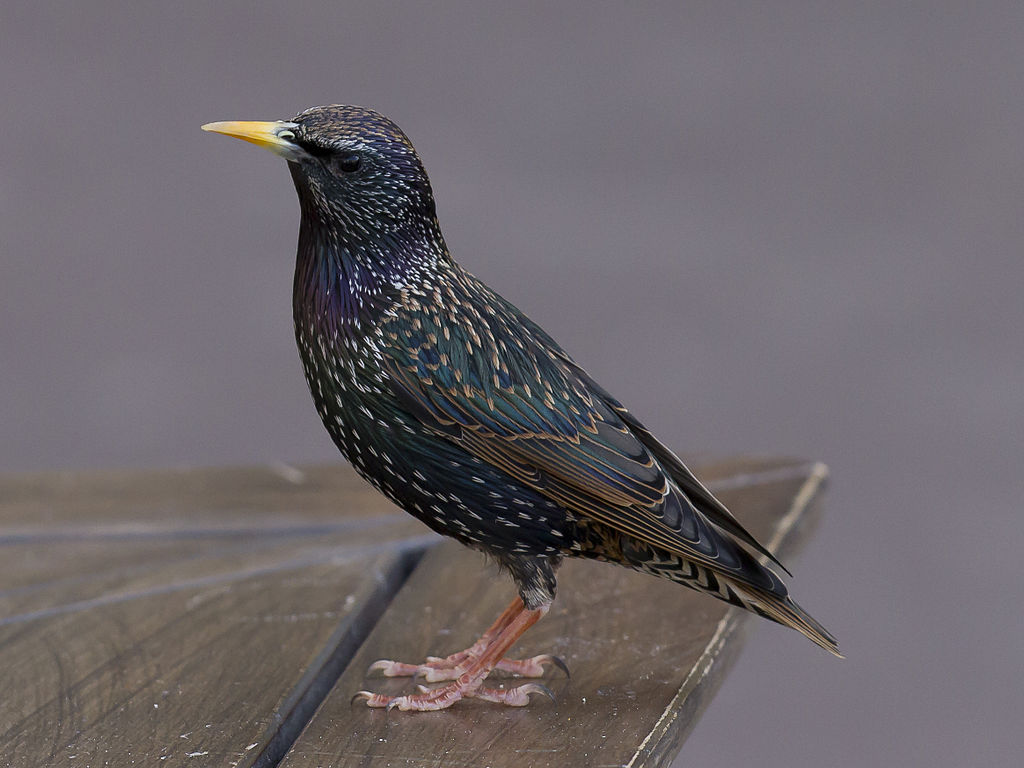
Coloration and Markings: European Starlings have some beautiful coloration when seen up close. In the warm months, their plumage is completely purple-green, with long wings and medium-length tails, and the coloration is broken only at the face by a large, straight yellow bill. In the winter, they mix things up a little by molting into brown plumage with white spots!
Size: These birds measure in at 7.9 – 9.1 inches in length with wingspans of 12.2 to 15.8 inches.
Habitat: These birds have learned that the best food opportunities are located wherever the people are. As such, you can spot them in farms, towns, and just about anywhere else where humans like to hang their hats.
Diet: Suet, Black Oil Sunflower seeds, and berries of just about any kind can tempt the European Starling into a feeder visit.
Dark-eyed Junco – Junco hyemalis

Coloration and Markings: You’ll get some variance from region to region, but in general a Dark-eyed Junco will be a dark brown or gray color for the upper 23 of the body and white below. They have long gray or brown wings and back and long, gray tails with white underneath. At the breast the white coloration will be centered, heavily flanked with the gray or brown like the bird has a vest, and this ‘vest color’ thins out as it approaches the underbelly. Facially, this bird is dark brown or gray and has a medium-length, stout pink bill.
Size: These birds measure in at 5.5 – 6.3 inches from head to tail and have wingspans veraging between 7.1 and 9.8 inches.
Habitat: When it’s warm, these birds favor coniferous and mixed-coniferous woods, but they do like to range into open areas from time to time. Yu might spot one in a field, park, or even on your fence checking out what you have in your feeder. Be sure to leave a little something out for them so that you can get a closer look!
Diet: A simple mix of cracked corn and Black Oil Sunflower seeds can lure and keep the attentions of a Dark-eyed Junco once the presence of the backyard feeder has come to their attention.
Barn Swallow – Hirundo rustica
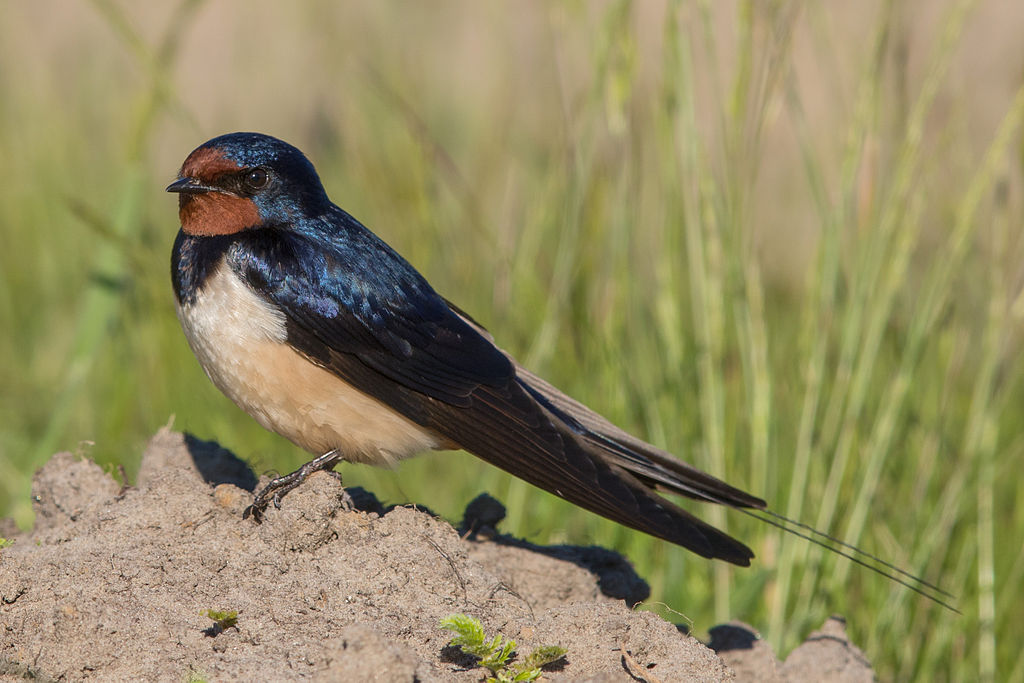
Coloration and Markings: Little superheroes, Barn Swallows have deep blue backs, with long blue wings that are slightly white-tipped at the shoulders. The blue color goes from the back to the front of the breast in the form of two lines, one on each side, going diagonally towards the center of the breast. It looks a bit like a cape-fastener. The breast and underbelly of this bird are a rich cinnamon color, which is concentrate the most between the ‘cape-clasp’ marks and up into the lower portion of the face. Here the cinnamon color outlines the undersides of the cheeks, continuing upward only at the center and stopping shortly over the bill. The upper portion of the face is deep blue and the look is completed with a sleek, diamond-shaped black mask. This bird has a small, straight, and sharp-looking bill. Females are marked the same but will have diluted coloration.
Size: These birds are roughly Sparrow-sized, measuring in at 5.9 – 7.5 inches in length and with wingspans of 11.4 to 12.6 inches.
Habitat: These birds love open areas and they aren’t shy of people. Look for them at golf courses, in fields, at the forest’s edge, and anywhere there is water. These little birds are quite fond of ponds and marshes.
Diet: While they usually won’t come for seeds or suet, you can sometimes have a little luck with berries (especially in winter). Ground up eggshells might also get their attention. These birds ingest them, possibly to aid in digestion.
Nebraska ‘s Birds of Spring, Summer, and Early Fall
Signs of spring in Nebraska can be slow coming during that time occasionally reffered to locally as the ’78 days of March’. When it starts warming, however, there are a number of winged wonders arriving with plans to stay sometimes until early fall. See if you can spot one of these birds during this time:
- Chipping Sparrow
- Orchard Oriole
- Cliff Swallow
- Summer Tanager
- Black and White Warbler
Chipping Sparrow – Spizella passerina
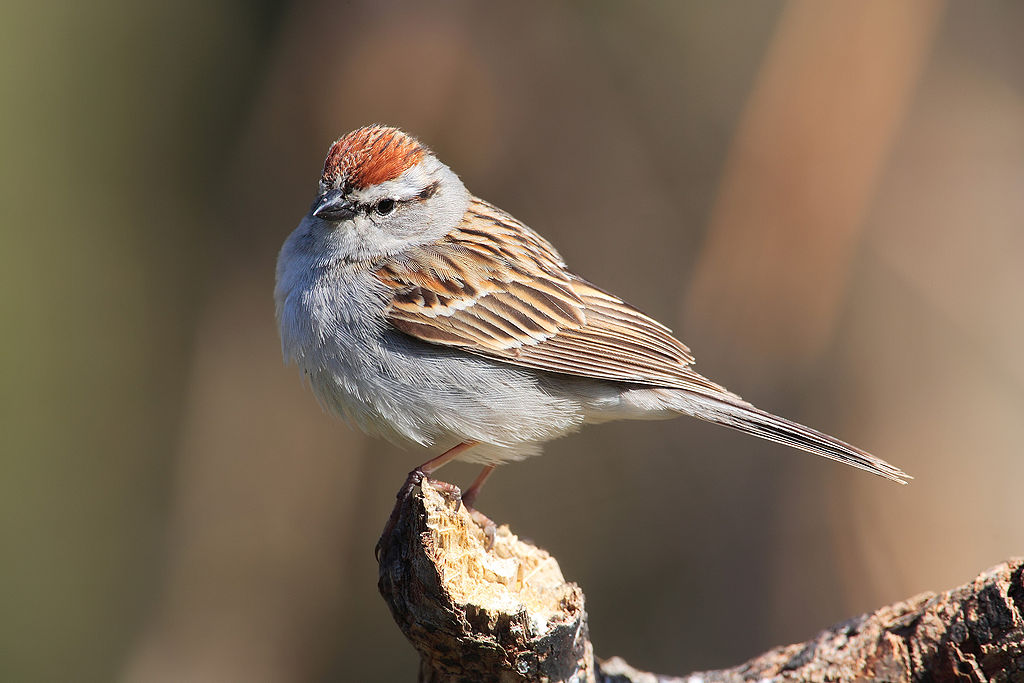
Coloration and Markings: Chipping Sparrows are handsome birds, with tan, neatly black-streaked backs and long wings. They have long tails which tend to be mor gray than tan (thought not always) and the breast and underbelly of this bird are a chilly, velvety gray that lightens a little at the underbelly. Facially, these birds have a mostly gray face, with a white mustache mark going from the bill and sometimes another white line next to it. The gray is heavily concentrated at the cheek and above this is a thin, black eyeline. Above the eyeline, you will see a layer of white just another a beautiful rust-red crown. In the winter they are harder to identify, being mostly a plainer, heavily streaked brown, but you can look for the dimmed eyeline and the somewhat muted cap and still know exactly which bird you are dealing with!
Size: These birds measure in at 4.7 – 5.9 inches in length with wingspans of approximately 8.3 inches in width from tip to tip.
Habitat: Chipping Sparrows love open areas, such as the forest’s edge, meadows, clearings, and copses. You’ll also see them in grassy fields and parks and these birds are frequent visitors to backyard feeders.
Diet: You can tempt these lovely little birds with suet, Black Oil Sunflower seeds, oats, and cracked corn.
Orchard Oriole – Icterus spurius

Coloration and Markings: The Orchard Oriole is colorful and easy to identify. They have black backs and shoulders, with a reddish-brown patch just under the shoulder on the wing, with the remainder of the wing being black with white highlights and a notable waxy reddish brown patch of vertical lines around the center of each wing. They have medium-length, black notched tails and the breast and underbelly of this bird are a striking reddish-brown. Facially, the bird is coal-black and this blacks starts from just under the base of the throat. This bird has a long, straight black bill with some slight curvature on the upper bill. Females are quite the exercise in contrast, being yellow-green rather than brown and bearing two distinct white wingbars. Juveniles look almost exactly the same as females but they will have some budding black at the throat and at the area of the bill that gives their gender away.
Size: These birds measure 5.9 – 7.1 inches from head to tail and have wingspans of approximately 9.8 inches.
Habitat: These birds love open woods, parks, pastures, and backyards. Your chances of a visit will increase greatly if you have some fruiting trees or vines.
Diet: Fresh fruit of just about any kind will do and break out your secret weapon… jelly! Some grape or strawberry jelly can really get an Orchard Oriole’s attentions, so give it a try and see for yourself! You might just make a colorful new friend.
Cliff Swallow – Petrochelidon pyrrhonota

Coloration and Markings: Cliff Swallows have dark blue backs and very long, dark brown wings with touches of black thrown in round the shoulders. The tail looks small because of the wings but it is of medium-length and squared at the ends and white colored towards the back (with some pumpkin coloration thrown in) but dark brown halfway down and to the tips. The breast and underbelly of this bird are white with some minor splashes of faint pumpkin color present around the throat and under the wings and facially, this bird has a wide, horizontal white line just under the base of the throat and loking up, you will see dark brown or black centered underneath the bill , followed with a brown eyestripe that terminates just as the back of the eye. This bird has a metallic blue cap which is white for a space at the front over the bill and the remainder of the bird’s face is a rich, reddish brown.
Size: These birds measure approximately 5.1 inches from tip to tail and have wingspans averaging between 11 and 11.8 inches in width.
Habitat: As the name suggests, these birds like cliffs and other high locations such as bridges when it comes for their preferred places to roost. They are fond of areas with water, however, so you might also glimpse one by a pond or a stream.
Diet: You might spot one of these birds in your backyard but it will probably not visit your feeder. Cliff Swallows like to catch insects while in flight but traces of seeds have been found in their stomachs before. Try some dried or live mealworms to get it’s attention and perhaps some hulled, Black Oil Sunflower seeds. You might just get lucky with this combination.
Summer Tanager – Piranga rubra
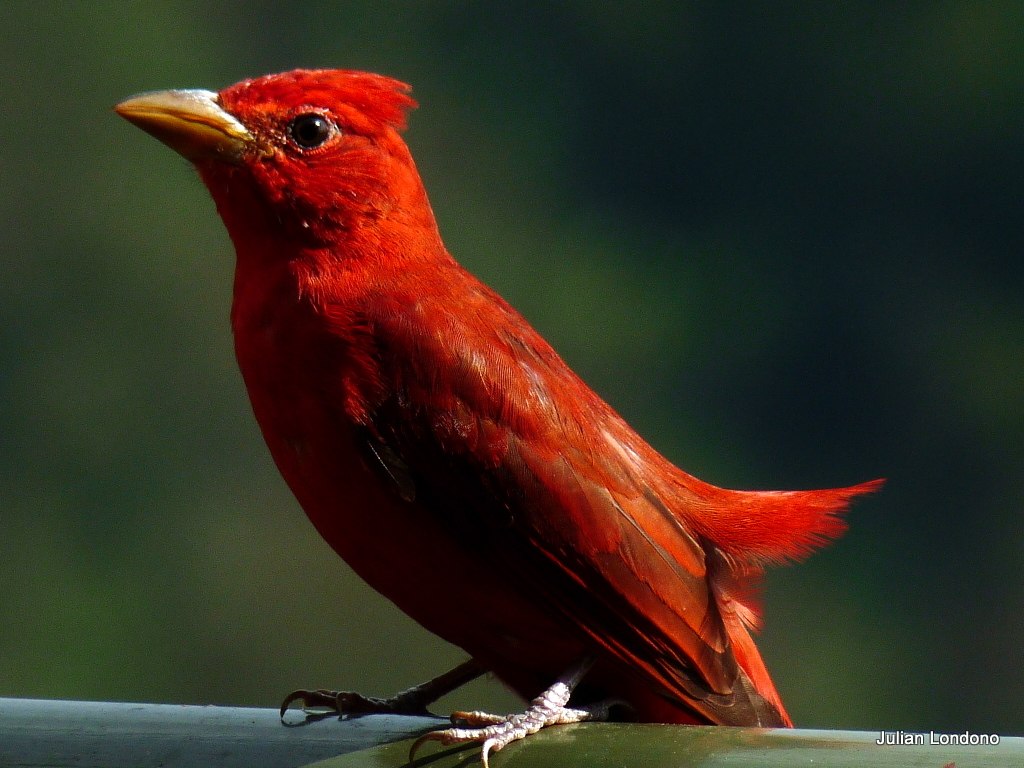
Coloration and Markings: Summer Tanager males are quite striking, being completely a deep red color. They have medium length wings and long, somewhat rounded tails. This bird has a stout, medium-length bill with a slight curve to it. Juvenile males tend to be a mix of yellow and red when they are molting between the seasons but otherwise they will look like the females. Look for bright yellow and green on the females with a concentration of the green particularly noticeable on the wings while a heavy saturation of yellow will be present on the head.
Size: These birds measure roughly 6.7 inches from tip to tail and have wingspans of 11 to 12 inches.
Habitat: These birds love wooded areas which ar open and are particularly fond of Evergreen stands and deciduous areas of forest.
Diet: Summer Tanagers are mostly insectivorous but will occasionally be tempted by suet cakes in your feeder.
Black and White Warbler – Mniotilta varia

Coloration and Markings: Black and White Warblers are beautiful and easy to spot. They have black and white striped backs and shoulders, with the remainder of their long wings being black with minute white edgings. They have two distinctive white wingbars which add some horizontal striping to go with the dominant vertical patterns and their tails are black, of medium length, and also have some tiny white edging to them. When in flight you might notice some black spots under the tail as well. The breast and underbelly of this bird are both white with lovely vertical black stripes and facially you wil notice a thin, white eyering within a black mask which angles down to the cheek and goes to the back of the head, with white below the cheek and a white eyebrow line above the eye. The crown is black and white in even stripes and this bird has a long, straight black bill with some minute curvature displayed on the upper bill. Females are a little muted in color and will display less streak-striping and often have a tan wash present on their flanks.
Size: These diminutive birds measure in at 4.3 – 5.1 inches in length and have wingspans of 7.1 to 8.7 inches.
Habitat: When it is warm these birds prefer deciduous or mixed deciduous woods, ranging out a bit when they forage to include the occasional park, woodlot, or backyard.
Diet: These particular Warblers eat mostly insects but will occasionally partake of suet cakes. Put some out and some dried mealworms or crickets and you might just get this bird’s attention.
Nebraska ’s Fall and Winter Birds
With lows around 10 degrees Fahrenheit, it is safe to say that Nebraska hosts what we will kindly call a ‘robust’ winter. These birds, however, don’t fret in the slightest or even consider the thought of a little time in South America. Rather, they keep a stiff-upper bill and tend to visit backyards quite a bit more frequently but you won’t hear them complaining. Help these tough little guys out with a full feeder and a warm birdbath if you’ve got one:
- Black-capped Chickadee
- White-breasted Nuthatch
- American Tree Sparrow
- Harris’s Sparrow
- Red-breasted Nuthatch
Black-capped Chickadee – Poecile atricapillus
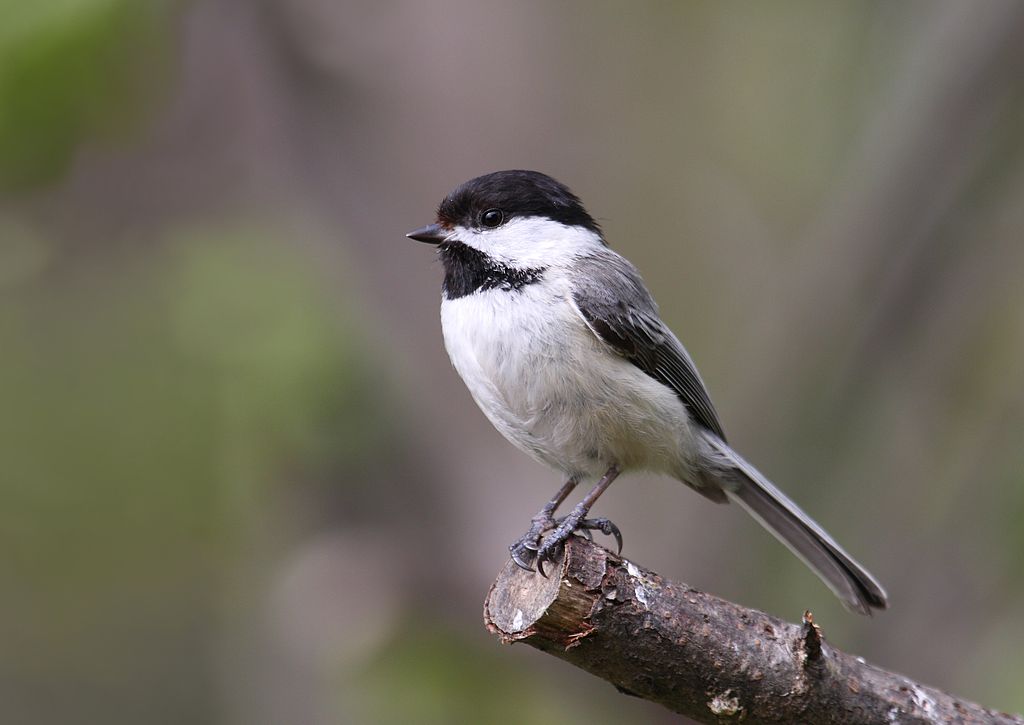
Coloration and Markings: Black-capped Chickadees have soft, velvety gray backs with medium length gray wings, bearing white edging as highlights, and they have long gray tails with white edges. The breast and underbelly of this bird are snowy white and facially the bird is white as well… barring the small black big and the Chickadee’s black cap, which goes down to a level just under the eyes. This bird has a tiny, conical black bill
Size: These birds measure in at 4.7 – 5.9 inches in lngth with wingspans of 6.3 to 8.3 inches.
Habitat: These birds love areas that have trees and a little dense foliage, such as brush, brambles, or simple shrubs. You can also spot them in marshes or overgrown fields and they are particular fond of Alder and Birch trees when selecting their nesting areas.
Diet: These little omnivores will eat just about anything but suet and chunky peanut butter is a particular favorite of Black-capped Chickadees.
White-breasted Nuthatch – Sitta carolinensis

Coloration and Markings: White-breasted Nuthatches have blue-gray backs, with black-highlighted medium-length blue-gray wings and medium-length, perky gray and black tails with white undersides. The breast and underbelly of this bird are paper-white, with the exception of a rust-red mark that you will see at the underbelly towards the rump. Facially, this bird is white as well with two exceptions. One if the thin, black line travelling diagonally and up from the back of the eye and the next is the long, thin black cap at the top of the birds head, which extends all the way down and slightly around the shoulders. This bird has a long, straight bill which is often black on top and white below.
Size: These birds measure around 5.5 – 5.5 inches in length and have wingspans of 7.9 to 10.6 inches in width.
Habitat: These birds loves the woods and they may be found within when they aren’t hanging around the edges. They are particularly fond of deciduous regions and seem to hang around Maple, Hickory, and Oak tree stands.
Diet: You can attract these birds with suet, peanuts, chunky peanut butter, or live mealworms if you are feeling like a most gracious host.
American Tree Sparrow – Spizella arborea

Coloration and Markings: American Tree Sparrows have rust-red and gray streaked backs, with medium-length wings bearing this streaking until you get close to the tips where they are a bit more gray. Two white wingbars are present and they have long, gray tails with a little rust-red on the outside and some white on the undersides. The breast and underbelly of this bird with reddish brown wash flanking from the shoulder to just under 23rds of the wing going down. Facially, these birds are gray, with a reddish-brown eyestripe which curves down slightly and almost reaches the back of the head. The head is topped off with a rusty-red crown and a short, straight, and stocky bill which is often black on top and yellow below. Sometimes a smudge will be present on the breast but while this is common you won’t always see it.
Size: These birds measure in at approximately 5.4 inches from head to tail and have wingspans around 9.4 inches.
Habitat: These birds of the forest’s edge love dense vegetation and may be spotted around marshes, overgrown fields, and virtually anywhere with a little brush or bramble they can hide in.
Diet: Some suet cake with a side of White Proso millet is a tried-and-true method of getting the American Tree Sparrow’s attention.
Harris’s Sparrow – Zonotrichia querula

Coloration and Markings: Harris’s Sparrows have quite the interesting plumage. Their backs and wings are streaked brown and black, with 2 thin, white wingbars present on the medium-length wings, and this bird has a long, thin gray tail which is white on the undersides. The breast and underbelly of this bird are white but you will see a flanking on the sides of the breast consisting of black dots while the underbelly will have a flanking of light brown streaks. Facially, this bird has a long bib carries down into the top-center of the breast and facially this black carries on up to the crown of the bird, stopping at the peak of the bird’s crest. This divides the face up in a quite pleasing manner, as the remaining portions of the face are gray with a touch of black sometimes present just behind the cheek. The black on the face spreads as the bird gets older so juveniles may have a rather ‘patchy’ black on their faces. These birds have large but short, conical pink bills.
Size: These Sparrows measure in at 6.7 – 7.9 inches in length with wingspans of approximately 10.6 inches.
Habitat: While most of these are in Canada, they have been spotted in Nebraska and prefer areas such as streamside-vegetation, pastures, parks, and the occasional backyard with a little bit of bushy cover.
Diet: You might have some luck with suet and these little guys like cranberries, so give those a try as well and you might just get a visit from this rare little wonder.
Red-breasted Nuthatch – Sitta canadensis
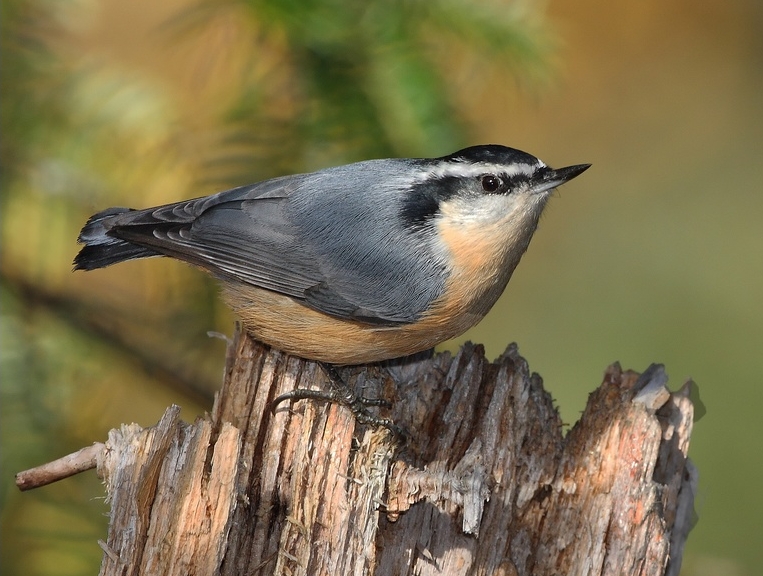
Coloration and Markings: Red-breasted Nuthatches have a smooth blue-gray coloration to their backs, as well as their long wings (which have a little black towards the tips) and their tiny blue-gray tails which are white on the undersides. The breast and underbelly of this bird are a cinnamon-brown color that is slightly more pronounced in the males and facially, these birds have white faces with a black mask that goes almost to the back of the head and finally, a thin, black crown on top. These birds have long, straight, and sharp-looking black bills.
Size: These little angels measure a mere 4.3 inches from tip to tail (on average) and have wingspans of 7.1 to 7.9 inches in width.
Habitat: These birds love coniferous woods and are especially fond of Oak and Maple stands. They will occasionally range out into parks and backyards as well, especially if you have one of those favored trees in your backyard!
Diet: Mix up some crunchy peanut butter with suet and you’ve got a killer-combo that Red-breasted Nuthatches simply LOVE. Give it a try, you (and those Nuthatches) will be happy that you did.
Supporting cast (Other Backyard Birds of Nebraska that might pay you a visit)
While they don’t get first billing, our ‘supporting cast’ birds are also present throughout the year and ready to entertain you with their songs and their antics. Keep an eye out for the following supporting cast stars this year:
- House Sparrow
- Northern Cardinal
- Downy Woodpecker
- American Goldfinch
- American Crow
House Sparrow – Passer domesticus

Coloration and Markings: House Sparrows have backs which are a mix of streaks, composed of black and foxy brown. They have medium-length wings and tails of the same color, though the tails are a little lighter. The underbelly of this bird is white heavily saturated with an ashy gray that continues up to the breast where sprinklings of black are present coming from the bird’s black bib. Facially, this bird is white around the cheeks and down across the shoulders, with a thick eyeline which is black until it goes behind the eye, where it is brown and curving around and down to frame the cheek. From the top of the bill to the back of the top of the head this bird is a smooth gray and it has a medium-length, stout bill with a noticeable curve on the upper half. Females tend to be a duller brown with brownish-gray breast and belly though their backs will have prominent striping of brown, black, and a foxy-tan.
Size: These birds measure in at 6.9 – 6.7 inches in length and have wingspans of 7.5 to 9.8 inches.
Habitat: These are city birds, though occasionally they will visit farms. Most often you can see them at parks, zoos, and most frequently in backyards. They are not shy of people and will happily visit your feeder if you’ve left a little something out for them.
Diet: Suet and shelled peanuts are an easy-to-provide treat that may attract and keep a House Sparrow’s attentions.
Northern Cardinal – Cardinalis cardinalis
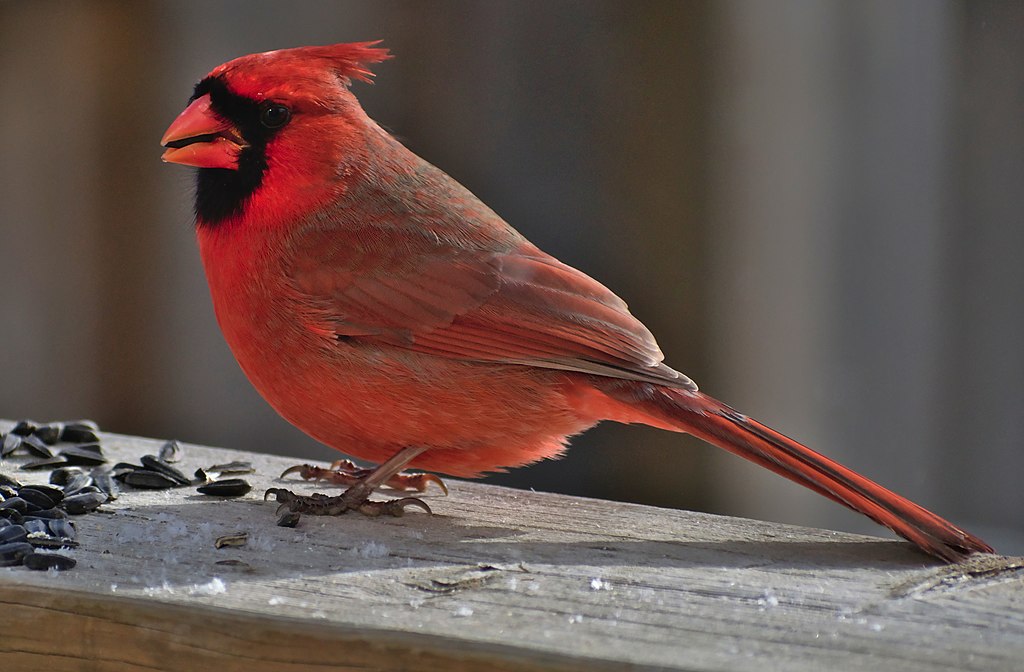
Coloration and Markings: American Cardinals are beautiful and probably the easiest North American bird to identify. They are completely a vibrant red from tip to tail and have long wings and tails as well as a stunning red crest. The only deviations in color are the occasional grays you’ll see when the bird is molting, it’s large, conical reddish-orange bill, and the distinctive black mask which covers the eyes and pulls sharply down below the bill in a ‘goatee’ type shape. Females tend to be a soft, lovely brown with reddish tinges on the body and very much recognizable as Cardinals.
Size: These birds measure at 8.3 – 9.1 inches from head to tail and have wingspans of 9.8 to 12.2 inches.
Habitat: Northern Cardinals are not shy of people and because of this, when they aren’t at the forest’s edge you can see them all around the city. Look up to phone lines or fence tops and you can often spot the Cardinal and they are more than happy to visit your backyard for some snacks.
Diet: Cracked corn and crushed peanuts are an easy combo that can attract American Robins and give you a closer look at these amazing birds.
Downy Woodpecker – Picoides pubescens
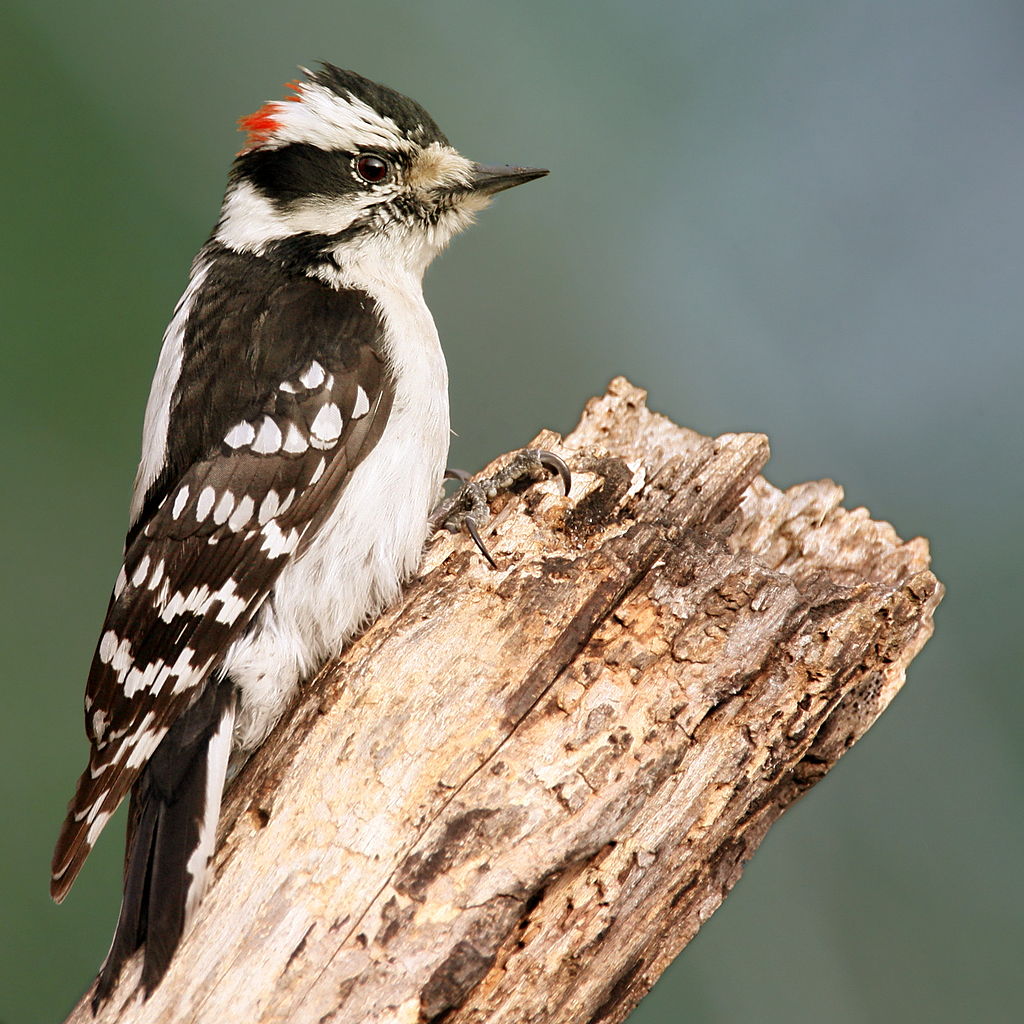
Coloration and Markings: Downy Woodpeckers are handsome little birds. They have a thick white stripe down the back, with black wings which are long and spotted with white blocks that give a checkerboard appearance to the wings. They have medium-length, noticeably notched tails which are black on top and white on the undersides, and the breast and underbelly of this bird are an immaculate white. This white carries up into the face, interrupted onnly by a black mustache line and a thick, black mask band that goes to the back of the head and highlights a thin, hite eyering on this bird. Finally, a thin, black crown is on the top of the head and in males it terminates at the back of the head at a red spot. For females it simply continues as black. These birds have thin, medium-length conical black bills.
Size: The smallest Woodpeckers in North America, these little guys measure in at 5.5 – 6.7 inches in length and have wingspans of 9.8 to 11.8 inches.
Habitat: These birds love deciduous woods where there are brambles, thorns, brush, and shrubs present. They range frequently into parks as they forage and are also commonly spotted in backyards where feeders have been thoughtfully loaded for them.
Diet: Suet is one of their favorite foods and these birds have been known to wash it down with a quick drink from a Hummingbird feeder. Apparently these little guys have a sweet tooth.
American Goldfinch – Spinus tristis

Coloration and Markings: Male American Goldfinches are bright little guys, with yellow backs and with black wings displaying 2 distinct white wingbars along with some vertical lines towards the center of the wings. They have long, pointy black tails which also bear white markings and which have a little white on the underside coming from the rump. The breast and underbelly of this bird are yellow, however, and this yellow carries on up into the face. Here you will see a black cap which starts at the forehead and goes down to the bill, which is short, stout, orange, and conical in shape. Females tend to have a more muted yellow and olive coloration in place of the male’s black and in winter these birds turn brown but their wingbars are still there, dim but present, and a dead-giveaway for identification once you’ve seen them before.
Size: These birds are tiny, measuring in at 4.3 – 5.1 inches in length with wingspans of 7.5 to 8.7 inches.
Habitat: These birds love areas of dense vegetation, such as overgrown fields, brush and areas prone to flooding. They also love orchards, gardens, and backyards but they tend to travel in flocks so stock a little extra in your feeder if you want them to hang around for awhile.
Diet: An easy treat for Goldfinches is a mixture of suet and crunchy peanut butter. They’ll love you for it, trust us!
American Crow – Corvus brachyrhynchos

Coloration and Markings: The clever and iconic American Crow is a breeze to identify. The bird is completely black, with long, black wings, a broad back, and a short, generally squared-off tail and it has a long, thick straight bill with a noticeable curvature on the top half of the bill.
Size: Twice the size of a Blue Jay, these birds measure in at 15.8 – 20.9 inches with wingspans of 33.5 to 39.4 inches.
Habitat: Crows hang out everywhere, from the woods, to the side of the road, to wide-open fields. They know we like to throw out food, too, and so they can occasionally be seen scavenging dumpsters or trash-cans. They are aggressive and remember faces so whatever you do, don’t make them angry!
Diet: If you put out a mix of cracked corn, oats, Black Oil Sunflower seeds, and some buckwheat you can make the Crows happy and they might even leave some suet for the other birds! You can also attract them with a crow silhouette, which is a classic old trick from the American southwest that also works on Ravens. Cut out of wood or tin and painted black, just put the silhouette up on a fence or pole and watch the Crows come a-visiting.
Nebraska Bird Buffet
If you’d like to know the best feeder strategy when it comes to setting out your feeders and what them to load them with to lure in the most diverse crowd of birds then we recommend an article. It’s from the University of Nebraska and you can find it in our reference links at the close of this article. It details a little bit of everything that you should know and is a printable .pdf file and today we’ll share a little bit of the feed information and add a little of our own as well. This should help you towards achieving that ever-elusive ‘perfect feeder combo’. Try some of the following items if you haven’t already:
- Chopped Apples
- Grape jelly
- Black Oil Sunflower seeds
- White Proso millet
- Cracked corn
- Suet cakes coated or mixed in crunchy peanut butter
Nebraska Birding Hot spots
The Chirparazzi are masters at getting a glimpse of the most elusive winged celebrities among us. Today they are sharing some of that hard-earned information and providing you with a list of hotspots aligned with compass points so that you can find a new place that is close to home and hosts some of the finest feathered stars in their natural habitats. Check the reference link if these are all too far, otherwise be sure to visit one of the following locations when the time allows:
- Northern hotspot – Niobrara Trail
- Eastern hotspot – Bellevue Loop Trail
- Southern hotspot – Pioneer Spirit Trail
- Western hotspot – U Street Pathway
- Central hotspot – State Street Trail
Detailed descriptions of each location as well as information regarding visiting and what birds you can see at these locations may be found at: https://www.traillink.com/stateactivity/ne-birding-trails/
Final Comments
Well, that is all of the time that we have for today, folks, and we hope you’ve enjoyed this ittle exploration into Nebraska birding. In this state you certainly won’t have to worry about running out of new birds to spot anytime soon but that doesn’t mean that you shouldn’t make a little time to mark some new birds off of your list. Get your binoculars and a good lunch that you can potentially share if you spot a new winged friend and then spend a little time outside. Birding is good exercise and its good for the soul, so what are you waiting for? It’s birding time!
